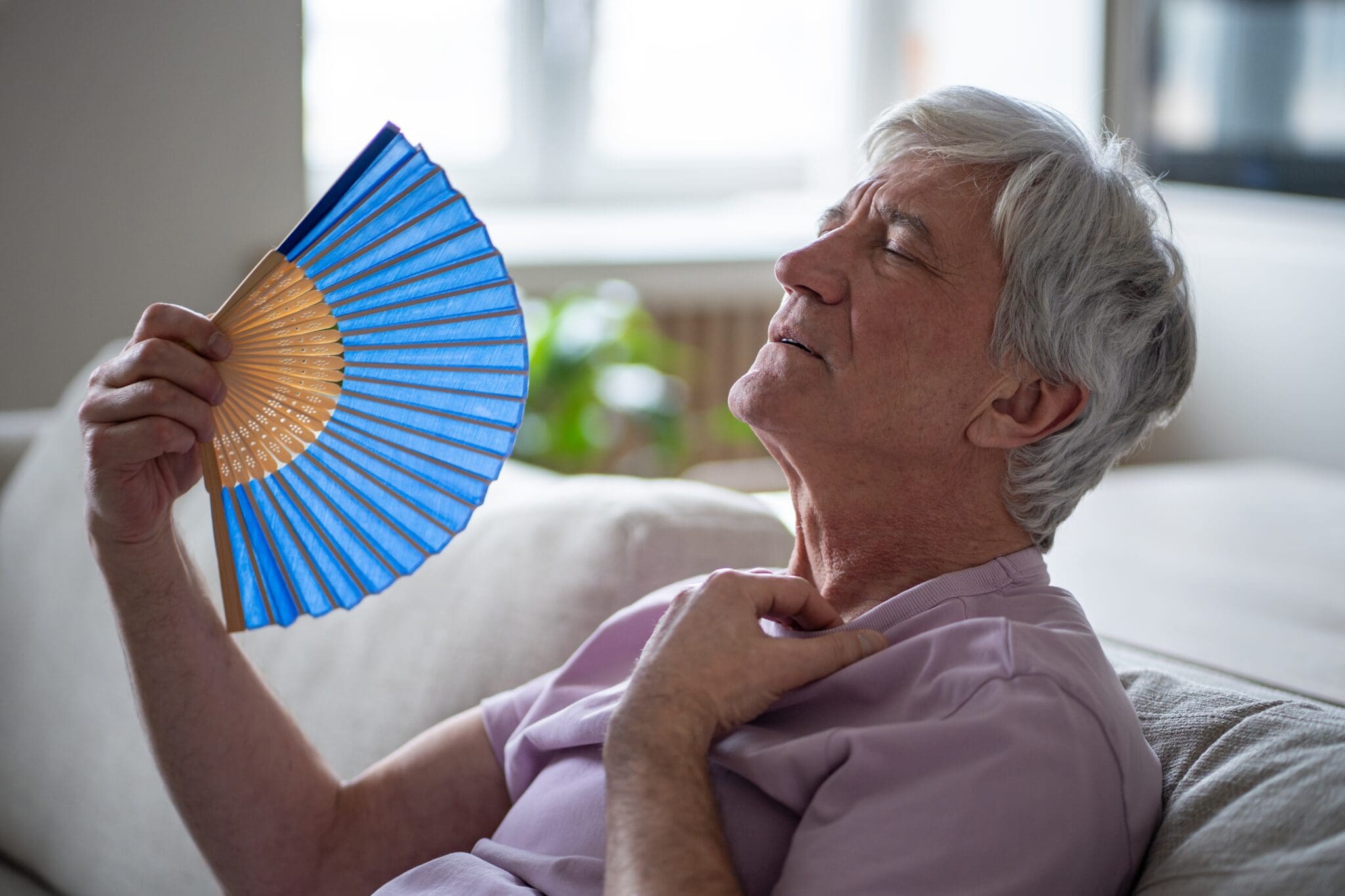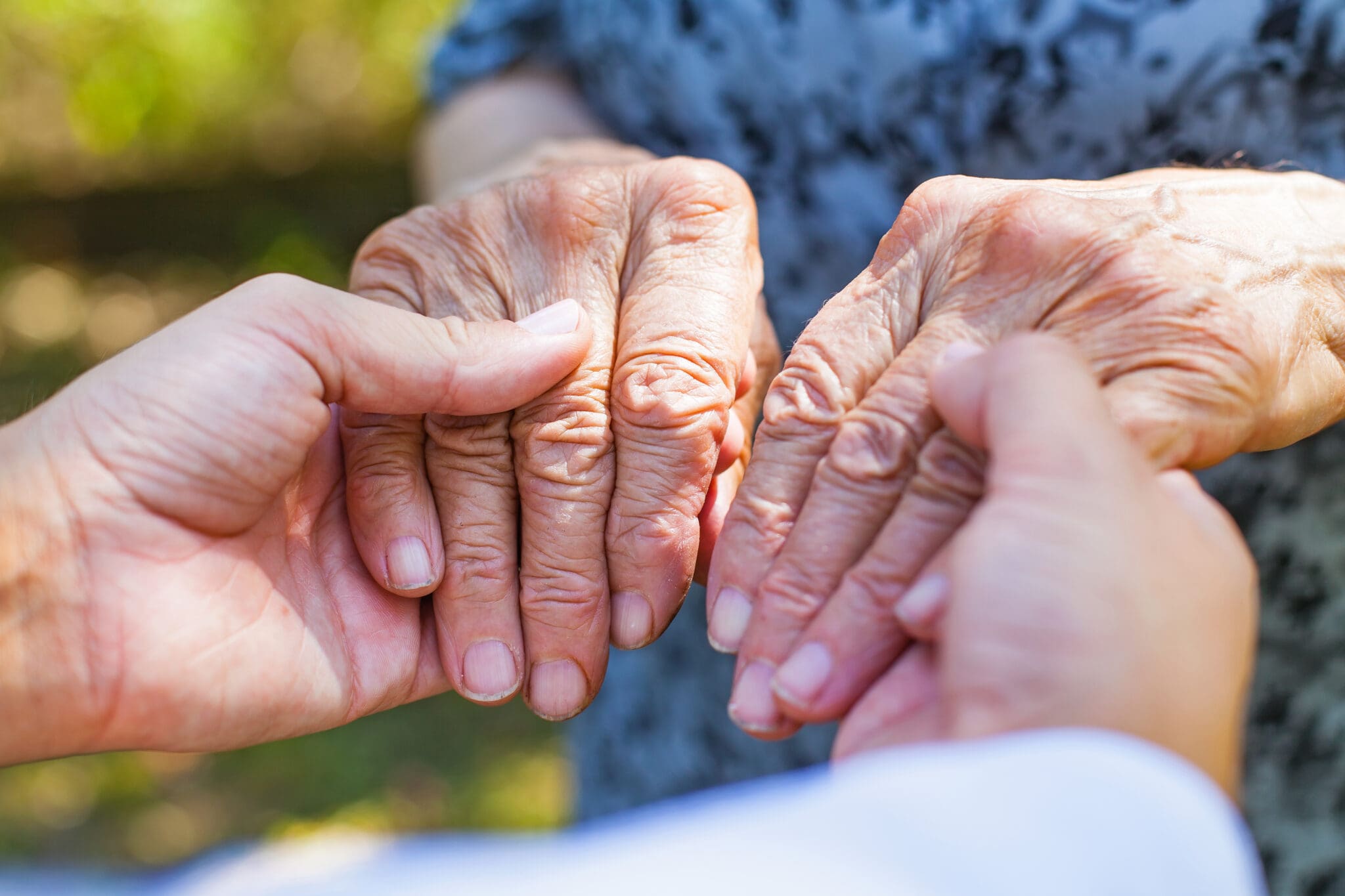In this article
Around 153,000 people live with Parkinson’s disease in the UK and by 2030, 172,000 people are expected to be diagnosed with the condition, making it one of the most common neurodegenerative conditions in the country. Whilst the majority of people develop symptoms of Parkinson’s disease after the age of 65, thousands of working age people are also affected by the disease.
According to the British Medical Journal (BMJ), men are slightly more likely to develop Parkinson’s disease than women, based primarily on studies of death rates and prevalence, with the relative risk being 1.5 times greater in men than women.
There are a number of famous celebrities who live with Parkinson’s disease, probably the most well-known being Michael J. Fox, who was one of the first celebrities to shine a light on Parkinson’s disease following his diagnosis in the early 1990s. More recently the musicians Ozzy Osbourne and Neil Diamond announced their diagnosis, as has actor and comedian Billy Connolly. By making their Parkinson’s diagnosis public, these celebrities help to raise awareness and understanding of the condition and potentially inspire others who are either living with Parkinson’s disease, or caring for someone who is living with the condition.
In this article we will examine Parkinson’s disease, its symptoms and causes, and will explore some of the care and support information available.
What is Parkinson’s disease?
In 1817, a British physician published an essay on the condition Shaking Palsy, his name was James Parkinson. Several decades after Parkinson’s death, Jean-Martin Charcot, a prominent neurologist who described and classified many diseases of the nervous system, formally recognised the significance of Parkinson’s work and renamed the condition Parkinson’s disease.
Parkinson’s disease is one of the most common neurodegenerative conditions in the UK, it affects predominately the dopamine-producing neurons in a specific area of the brain called substantia nigra. The substantia nigra (SN), is located midbrain and is a part of the basal ganglia, it plays a crucial role in motor control, reward processing, and learning. Specifically, it is known for producing dopamine, a neurotransmitter that affects various brain functions, including movement, cognition, and emotional processing. Damage to the SN, as seen in Parkinson’s disease, can lead to impaired motor control due to the loss of dopamine neurons.
The brain uses neurotransmitters to control how brain cells (neurons) communicate with each other. Dopamine is one of the most important neurotransmitters, fine-tuning the movement signals sent from the brain that tells the muscles to move. In Parkinson’s disease dopamine production is impaired and this lack of dopamine causes the slowed movements and tremors that are characteristic of Parkinson’s disease.
Parkinson’s disease is a progressive neurodegenerative disorder that progresses over time, meaning that the symptoms of the disease will gradually get worse, and impacts various aspects of the person’s life, although the disease is highly variable from person to person affecting each individual differently. Whilst Parkinson’s is primarily characterised as a movement disorder, people affected by the condition may eventually develop Parkinson’s dementia, a subtype of Lewy body dementia. However, the onset and progression of cognitive decline will vary from person to person.
There is no cure for Parkinson’s disease, so early diagnosis and treatment is crucial for managing the symptoms and for slowing the progression of the disease.
Symptoms of Parkinson’s disease
Whilst there are no specific tests to diagnose Parkinson’s disease, a Neurologist can diagnose Parkinson’s disease based on a person’s signs, symptoms, physical examination and medical history. They may also arrange for a brain scan, such as a single photon emission computed tomography (SPECT) scan, to try to rule out other potential causes for the symptoms displayed.
As Parkinson’s disease affects people differently, not everyone with Parkinson’s disease experiences all these symptoms or identical combinations of these symptoms, as they often vary from individual to individual. Symptoms are also known to change from day to day and in certain circumstances, from hour to hour. The most common symptoms of Parkinson’s disease include:
- Tremors (shaking)
- Pain
- Slowness of movement
- Involuntary movement
- Rigidity (stiffness)
- Restless legs syndrome
- Trouble walking
- Imbalance
- Falls and dizziness
- Cramped or small handwriting
- Bladder and bowel problems
- Sensory disturbances
- Eye problems
- Sleep disorders
- Mood changes
- Cognitive impairment
- Mental health disorders
- Hallucinations and delusions
- Dementia
- Speech and communication problems
- Skin, scalp and sweating problems
- Problems with swallowing
The Hoehn and Yahr scale is a widely used tool that is most frequently used in the NHS for assessing the progression of Parkinson’s disease in the UK. It is routinely used for describing how Parkinson’s symptoms develop and helps determine the severity of the disease. There are five distinct Parkinson’s disease stages:
- Stage 1 – this is the mildest form of Parkinson’s that any individual can experience. During this stage, there may be slight symptoms, but these are not severe enough to significantly impact daily tasks and overall standards of living. In many cases, Parkinson’s symptoms can be so minimal that they are easily missed. A common stage 1 symptom of Parkinson’s disease is tremors or other movement difficulties only impacting one side of the body. Some individuals in this stage may notice changes in posture, walking and facial expressions.
The progression between stages 1 and 2 can take months or even years, and there is no way to accurately predict how long it will take for an individual to progress between these stages of Parkinson’s disease.
- Stage 2 – this second stage is a moderate form of Parkinson’s as the symptoms are more noticeable than the previous stage. Stiffness, trembling and tremors may be more severe and occur across one or both sides of the body, there are also changes in facial expression that can become more apparent. Daily tasks and activities will become more difficult and time-consuming to accomplish, however the individual can retain their independence.
- Stage 3 – this is considered the “middle stage”, marking a major turning point in the progression of the disease. The symptoms remain similar to those in stage 2, however, individuals within this stage are now more likely to experience decreased reflexes, loss of balance and all-around slower movement. Falls become more common within stage 3 as general coordination begins to decrease considerably. A person within this stage can remain fully independent, however the symptoms can significantly impact daily activities such as dressing, washing and eating and they may require help from a caregiver.
- Stage 4 – this is the stage where most people with Parkinson’s disease begin to lose their independence and have to rely on care and assistance in order to live comfortably. Symptoms become severe making it dangerous to live alone, and restricting the overall capacities of the individual considerably. They will now require help with most daily tasks and activities, and whilst it may be possible to stand without any assistance, walking from one place to another will require assistance from a caregiver, and / or a device such as a walker.
- Stage 5 – this is the most advanced of the Parkinson’s disease stages. The person’s legs can become so stiff that it becomes almost impossible to stand or walk, and balance and control of the body also continue to decrease. To combat this, the individual may require a wheelchair to move around, or alternatively, may become bedridden, and the person will require around-the-clock assistance to prevent injury through falling. At this stage, between 8 and 40% of people experience confusion, delusions and hallucinations, and dementia can develop, making it difficult for the individual to concentrate, converse and to think clearly. Up to 70% of people with Parkinson’s disease will go on to develop dementia, as the damage caused by Parkinson’s spreads throughout the brain. A full-time carer will be required at this stage of Parkinson’s disease.
A person with Parkinson’s disease moves through each of these stages at varying rates; some people spend years in each stage, whilst others progress to an advanced stage more quickly. The appropriate management at each of these stages are outlined in guidance produced the National Institute for Clinical Excellence (NICE).

What causes Parkinson’s disease?
Parkinson’s disease is predominantly age-related, and the prevalence of Parkinson’s disease increases significantly with age as ageing affects many cellular processes that predispose a person to neurodegeneration. Parkinson’s disease is one of the main neurological conditions to affect older people and is predicted to increase alongside the longevity of the UK population.
As we have described earlier, Parkinson’s disease is caused by a loss of nerve cells in the substantia nigra (SN), leading to progressive damage to several areas of the brain over many years. The reason for this loss of nerve cells remains unclear, and researchers are still unclear as to what specific age related factors predispose some individuals to develop Parkinson’s disease, although some research suggests the cause is due to a mixture of genetic and environmental factors.
Exposure to air pollution, pesticides and solvents may increase the risk of developing the disease, and people with a family history of Parkinson’s have a higher risk of developing it. Research has identified over 90 genes that can increase the risk of developing Parkinson’s.
Although symptoms usually appear after the age of 60 years in most people with Parkinson’s disease, in between 5 – 10% of cases symptoms appear before the age of 50 years, and this is known as early onset Parkinson’s disease. Also in some rarer instances, the symptoms start appearing before the age of 20 years, and this is known as juvenile Parkinson’s disease. In both early onset and juvenile Parkinson’s disease, scientists do not know exactly what causes the condition, but believe that there is a genetic cause, and that the disease may be hereditary.
The are some studies that have shown that individuals with a history of traumatic brain injury, or a history of melanoma may have an increased risk of developing Parkinson’s disease. The exact mechanisms linking traumatic brain injury and Parkinson’s disease are still being investigated, but potential pathways include inflammation, Alpha-synuclein aggregation, this is a protein that can build up in Parkinson’s disease, and damage to brain cells in the basal ganglia which is where substantia nigra (SN), is located.
Medication management
Currently, there is no cure for Parkinson’s disease, but there are various medications, therapies and treatments that can help to control the symptoms of the disease on a day to day basis and that can make living with Parkinson’s disease easier to deal with.
As with the symptoms of the disease, the medications and treatments prescribed can also vary from person to person, depending on their specific symptoms, and how well certain medications and treatments work. Before starting any treatment, the person’s individual circumstances, including symptoms, comorbidities and preferences are discussed with them. The medical professionals should also point out the potential benefits, risks and side effects from the different drugs available.
In the early stages of Parkinson’s disease, individuals whose motor symptoms including tremors and movement problems are decreasing their quality of life, are usually prescribed a drug named levodopa, with the aim to improve overall motor performance.
Levodopa is absorbed by the nerve cells in the brain and turned into the chemical dopamine. Increasing the levels of dopamine by using levodopa usually improves a person’s movement problems. Levodopa does however have some side effects which may include feeling and being sick, tiredness and dizziness. To help to combat these side effects, Levodopa is combined with other medication such as carbidopa (co-careldopa) or benserazide (co-beneldopa).
Levodopa is usually prescribed in low doses to start and its effectiveness regularly reviewed. The dosage will be gradually increased as its impact will decrease over the years as more nerve cells in the brain are lost meaning that there are fewer cells to absorb the medication. Long-term use of levodopa can also cause uncontrollable, jerky muscle movements and may cause the person to switch rapidly between mobility and immobility.
Other types of medication that are commonly used as an alternative to, or as a supplement to levodopa, include dopamine agonists and monoamine oxidase-B inhibitors.
Dopamine agonists have a similar but milder effect compared with levodopa. Sometimes dopamine agonists are taken at the same time as levodopa, as this allows lower doses of levodopa to be used. Dopamine agonists bind to dopamine receptors in the brain, mimicking the actions of dopamine. By stimulating these receptors, dopamine agonists help to improve Parkinson’s motor symptoms.
Dopamine agonists are usually prescribed in low doses to start and its effectiveness regularly reviewed. There are risks and side effects associated with dopamine agonists that can range from common issues such as drowsiness, dizziness, and nausea, to impulse control disorders, hallucinations and increased confusion, so they need to be used with caution, particularly in elderly people with Parkinson’s, who are more susceptible. Long-term use of dopamine agonist can also lead to movement problems and psychiatric disturbances, and a potentially serious, but uncommon, complication, a sudden onset of sleep, so people are usually advised to avoid driving in case this complication occurs.
Monoamine oxidase-B inhibitors work by blocking the enzyme MAO-B, which breaks down dopamine in the brain. They are an alternative to levodopa for treating early Parkinson’s disease as they are generally very well tolerated, but can occasionally cause side effects including nausea, headaches, abdominal pain and high or low blood pressure. They can also be used alongside levodopa or dopamine agonists. According to the National Institutes of Health (NIH), in addition to improving motor symptoms, monoamine oxidase-B inhibitors may have potential neuroprotective effects, which could help slow the progression of Parkinson’s disease.
The progressive nature of Parkinson’s disease inevitably means the dosage of prescribed medication increases and there is a need for new medications and/or regimen adjustments on a regular basis. This often results in people receiving combination therapy. Multiple formulation options and combinations can make medication regimens appear very complicated. This can be confusing for a person with Parkinson and also for their carer(s), and failure to take medications on time or in the correct dosage, either intentionally or accidentally, can lead to serious complications including pneumonia which is the leading cause of death in people with Parkinson’s disease.
In most cases the medications prescribed for Parkinson’s are initially supplied in either tablet or liquid form. However, as the disease progresses, oral medications may not be suitable, and advanced, generally non-oral treatments and therapies may be recommended, including administering medication through an enteral tube to the stomach, or in some exceptional cases the person undergoing Deep Brain Stimulation (DBS).
DBS is not a routine treatment, and access to it can vary depending on the specific NHS trust and specialist centres offering the procedure. The surgery involves implanting thin wires (leads) into specific areas of the brain, which are connected to a pulse generator this is a device similar to a pacemaker, that is placed under the skin. After surgery, the device is programmed and adjusted to optimise its effectiveness. DBS can significantly reduce or eliminate symptoms such as tremor, rigidity, and slow movement associated with Parkinson’s disease and in some cases allow individuals to reduce the amount of medication they need, potentially improving their tolerance to medication.
People with Parkinson’s disease will also experience a number of non-motor related additional symptoms that may need to be treated separately, some of which may require medication such as:
- Depression and anxiety – selective serotonin reuptake inhibitors (SSRIs) are frequently the first-line treatment for depression and for anxiety, citalopram and benzodiazepines are usually prescribed
- Insomnia – Melatonin is a commonly prescribed option, with some evidence suggesting it improves sleep quality and daytime sleepiness in people with Parkinson’s
- Pain – Some medications used to treat Parkinson’s motor symptoms such as dopamine agonists, and levodopa can also help with certain types of pain, alternatively paracetamol and nonsteroidal anti-inflammatory drugs (NSAIDs) such as ibuprofen can be used for musculoskeletal pain and inflammation. Botox can be used to treat muscle contraction, which can cause pain and stiffness.
- Drooling of saliva – Botox might be considered if non-medication treatments such as speech and language therapy is not available or is ineffective.
- Parkinson’s disease dementia – acetylcholinesterase inhibitors such as donepezil, rivastigmine, and galantamine, and memantine can help to improve memory, thinking, and other cognitive functions affected by Parkinson’s disease.
- Hallucinations and delusions – The primary medication for treating hallucinations and delusions in Parkinson’s disease is pimavanserin, it is specifically designed for this purpose and avoids worsening motor symptoms.

Diet and nutrition
Regular exercise and a healthy, balanced diet can help to improve well-being in people with Parkinson’s disease. Simple exercise such as walking or stretching can help to relieve muscle stiffness, improving mood and relieving stress. A balanced diet containing all the food groups, particularly fruits and vegetables promotes health and well-being.
Diets rich in antioxidants and omega-3 fatty acids may benefit people with Parkinson’s disease. Some researchers suggest that the Mediterranean diet, which tends to be high in antioxidants and omega-3s, protects against dementia in Parkinson’s disease.
Antioxidants protect against oxidative stress in Parkinson’s disease. Oxidative stress is an imbalance of antioxidants and unstable compounds called free radicals. Oxidative stress plays an important role in the degeneration of dopaminergic neurons in Parkinson’s disease. Some specific antioxidants include vitamin C, vitamin E, and carotenoids such as beta-carotene, and are found in for example:
- Fruits such as blueberries, strawberries, raspberries, blackberries, cranberries, apples, oranges, kiwifruit, mangoes, and grapes
- Vegetables such as broccoli, cabbage, cauliflower, spinach, kale, Swiss chard, carrots, sweet potatoes, tomatoes, and bell peppers
- Nuts and seeds such as pecans, almonds, walnuts, and other nuts, flaxseeds, chia seeds, pumpkin seeds, and sunflower seeds
- Legumes such as beans and lentils
- Herbs and spices such as cloves, peppermint, and cinnamon
- Dark chocolate
- Green tea
Diets that are rich in omega-3 fatty acids may benefit people with Parkinson’s disease as they can reduce inflammation, promote neuroplasticity, and regulate neurotransmitter function. Omega-3 fatty acids are found in foods such as:
- Fatty Fish such as salmon, sardines, tuna, mackerel, and anchovies
- Soybeans
- Brussels sprouts
- Eggs
Other nutrients that should be included in a diet for a person with Parkinson’s include but are not limited to:
- Iron found in spinach, beef, tofu, and some fortified breakfast cereals
- Vitamin B1 (thiamine) found in pork, beans, lentils, and peas
- Zinc found in whole grains, red meat, oysters, and chicken
- Vitamin D found in salmon, tuna fish, fortified dairy products, and cod liver oil
- Calcium found in dairy products, green leafy vegetables, and fortified soy products
Many foods can help to alleviate some of the symptoms of Parkinson’s disease, however other may inhibit the effectiveness of some medications, so it is beneficial to make diet and nutrition adjustments such as:
- Swallowing problems – softening food, taking smaller bites, or adding foods that will stimulate swallowing such as seasoned or sour foods or carbonated drinks that can help to overcome this issue. Diets can include pureed foods, soups, soft cooked vegetables, and tender meats.
- Constipation – Aiming to drink six to eight 8 glasses of water each day and drinking warm liquids, especially in the morning, can stimulate bowel movements. Dietary sources of fibre that consist of fruits with the peel, vegetables, legumes, whole grain breads and cereals also help regular bowel movement. Most of these are high in antioxidants, as well.
There are also foods that should be minimised, if not avoided altogether when a person has Parkinson’s. For example, taking levodopa with high-protein meals, such as meat and fish, may reduce how much of the medication gets into the system and how well a dose works. This is because levodopa is a protein building block, so it competes for absorption with other proteins. If medication doesn’t seem to be working its best, or if it is wearing off before it is time for the next dose, doctors usually recommend taking the dose on an empty stomach about 30 minutes before or 60 minutes after a meal. Iron supplements can also decrease absorption of levodopa.

Caregiver support
Parkinson’s disease does not just affect the person with the condition; it also affects partners, family, and friends, some of whom may be caregivers. Caring for a loved one with Parkinson’s, especially when they are in the advanced stage is a difficult and emotional task, even for the strongest of people, and often caregivers begin to neglect their own wellbeing. An NHS SACE survey found that 20% of carers felt they are neglecting themselves, and Carer’s UK State of Caring survey 2023 found that:
- Over three quarters (79%) of carers feel stressed or anxious
- Half of carers (49%) feel depressed
- 54% of carers said their physical health had suffered.
When caregivers feel overwhelmed, tired and lonely, which are natural feelings experienced at some point by anyone caring for a loved one with a progressive and debilitating disease, it not only impacts the caregiver’s mental and physical health, it also affects the level and quality of care that they are able to provide for their loved one.
- This is why it is important that caregivers get the right mental, physical and practical support. Carer’s UK is a charity that can help to provide that support with advice, guidance and practical help in areas such as finance, health and wellbeing, and advocacy for caregivers.
- Parkinson’s UK offer a help and advice line to caregivers, they can be contacted on 0808 800 0303.
- Parkinson’s Care and Support UK offer a range of information and support for Parkinson’s caregivers including respite care to give caregivers well needed breaks.






